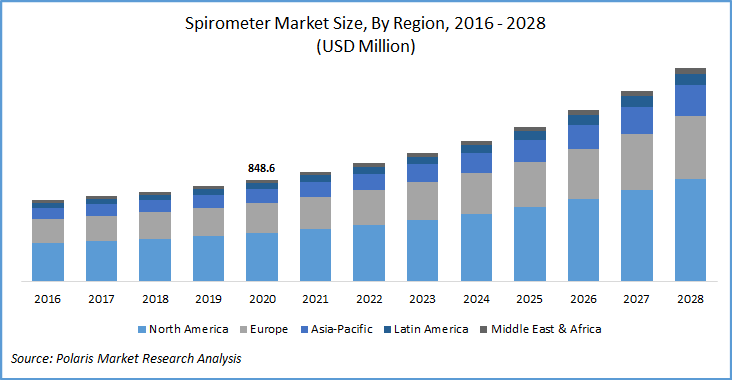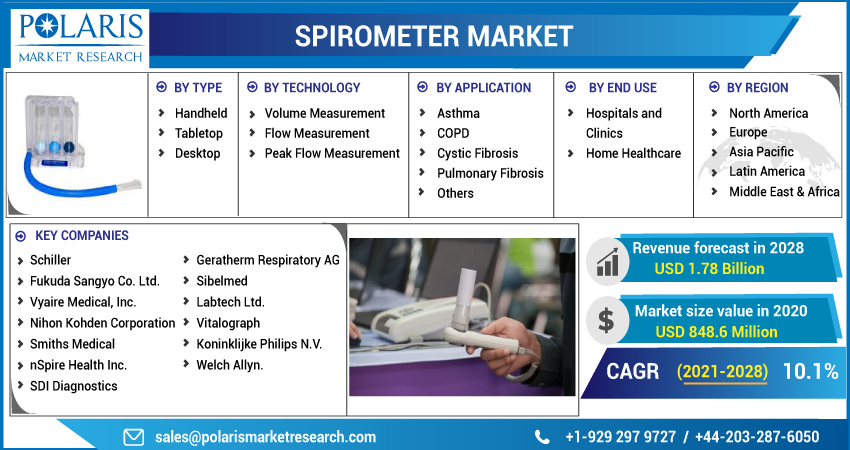
Spirometer Market Share, Size, Trends, Industry Analysis Report, By Type; By Technology (Volume Measurement, Flow Measurement, Peak Flow Measurement), By Application (Asthma, COPD, Cystic Fibrosis, Pulmonary Fibrosis, Others); By End-Use; By Regions; Segment Forecast, 2021 - 2028
- Published Date:Feb-2021
- Pages: 104
- Format: PDF
- Report ID: PM1799
- Base Year: 2020
- Historical Data: 2016-2019
Report Outlook
The global spirometer market was valued at USD 848.6 million in 2020 and is expected to grow at a CAGR of 10.1% during the forecast period. The prominent factors boosting the market growth include the rising prevalence of respiratory disorders, the aging population across the globe, favorable government policies to promote awareness regarding the ill effects of respiratory problems, and miniaturization of spirometers. Approximately, 2 billion individuals across the globe are exposed to air pollutants on a daily basis. These harmful gases have an adverse impact on the lungs.
The market research report offers an in-depth analysis of the industry to support informed decision-making. It offers a meticulous breakdown of various market niches and keeps readers updated on the latest industry developments. Along with tracking the spirometer market on the basis of SWOT and Porter’s Five Forces models, the research report includes graphs, tables, charts, and other pictorial representations to help readers understand the key insights and important data easily.

Know more about this report: request for sample pages
Industry Dynamics
Growth Drivers
Companies in the market are introducing technologically advanced products to simplify the diagnosis process of pulmonary testing, for both physicians and medical professionals. The objective is to develop a spirometer providing higher yield with the enhanced patient comfort. Moreover, these firms are adopting innovative medical coating to prevent any kind of infection. Thus, technological advancements like this create the testing procedure simpler and easier.

For Specific Research Requirements, Request for a Customized Report
The use of spirometry for asthma in pediatric patients particularly in resource-poor countries having a high burden of communicable diseases is low, owing to its high cost and non-availability of technical staff. Companies are employing strategies to increase the adoption of spirometers among low-income countries. Modern spirometry equipment standardizes results to provide quick responses. Thus, companies increasing their market share in the emerging nations, expected to drive the market growth for spirometers.
Spirometer Market Report Scope
The market is primarily segmented on the basis of type, technology, application, end-use, and region.
|
By Type |
By Technology |
By Application |
By End Use |
By Region |
|
|
|
|
|
Know more about this report: request for sample pages
Insight by Type
Based upon the type, the global spirometer market is categorized into handheld, tabletop, and desktop. Of all, the tabletop segment held the largest share in the global market in 2020, owing to its extensive usage in the diagnosing of respiratory diseases and other pulmonary disorders. However, the handheld type is expected to register a lucrative growth rate over the study period.
This high growth is due to its ability to provide integrated insights with informed clinical decisions. These spirometers are compact and can produce and store hundreds of diagnostic tests in digital form. Moreover, results could be transferred via flash drives in the form of electronic medical records.
Insight by Technology
On the basis of technology, the flow measurement spirometer industry segment held a significant market share, in 2019. This high share is attributed to its wide application in respiratory function testing. However, the peak flow spirometer industry segment is expected to register the fastest growth over the forecast period. These devices have the unique ability to provide warnings on the onset of an asthma attack by analyzing patterns of contraction of lungs. Thus, asthma patients would be advised on time for proper action.
Insight by Application
Based upon application, the global spirometer market is categorized into asthma, COPD, cystic fibrosis, pulmonary fibrosis, and others. In 2020, the COPD segment held the largest revenue share, owing to rising cases of COPD across the globe, and significant government-based funding. However, asthma is expected to major factor driving the demand in the market for spirometers over the forecast period.
The rising economic burden of asthma patients and the emergence of innovative apps is increasing the adoption of spirometers. U.K based NHS has reported that each year around USD 1 billion, has to spend to treat asthma patients in the country.
Insight by End Use
On the basis of end-use, the hospitals and clinics segment held a significant market share, in 2019, owing to high patient admissions in the healthcare facilities. Spirometers are costly instruments and only hospitals can easily afford such a high price. However, the home healthcare segment is expected to witness a higher growth rate over the forecast period. Such a significant increase is attributed to rising in respiratory diseases among the old age population. Moreover, the advancements in telemedicine and concerned digital initiatives also boosting the market growth for spirometers.
Geographic Overview
Geographically, the global market for spirometers is bifurcated into North America, Asia Pacific, Europe, Latin America, and Middle East & Africa. North America is the largest revenue contributor followed by Europe and the Asia Pacific region. In 2019, the North America region accounted for over 40 percent of the global market.
The factors responsible for the region’s market growth include the high prevalence of COPD and favorable government policies. For instance, according to the estimates of the CDC, the treatment cost for COPD in the U.S. is estimated to reach USD 90 billion, by 2020. Moreover, the improvement in the technology of the spirometer also favoring the market growth. However, APAC spirometer industry is expected to register a lucrative growth rate, owing to improving primary healthcare facilities and proper strategies in place to manage chronic lung disorders.
Competitive Insight
Some of the major players operating the global market for spirometers include Schiller, Fukuda Sangyo Co. Ltd., Vyaire Medical, Inc., Nihon Kohden Corporation, Smiths Medical, nSpire Health Inc., SDI Diagnostics, Geratherm Respiratory AG, Sibelmed, Labtech Ltd., Vitalograph, Koninklijke Philips N.V., and Welch Allyn.
We provide our clients the option to personalize the spirometer market report to suit their needs. By customizing the report, you can get data as per your format and definition. Also, the customization option allows you to gain a deeper dive into a specific segment, region, customer, or market competitor.
